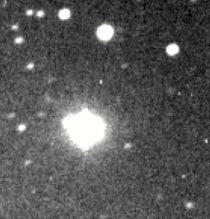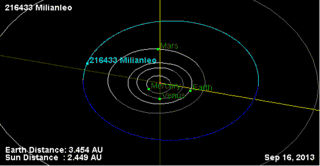216433 Milianleo
216433 Milianleo, provisional designation 2009 DM3, is an Aeolia asteroid from the central region of the asteroid belt, approximately 1.6 kilometers (1 mile) in diameter. It was discovered 19 February 2009, by German amateur astronomer Erwin Schwab using a remote-controlled telescope at Tzec Maun Observatory (H10) in Mayhill, New Mexico, United States. The asteroid was named after the discoverer's son, Milian Leo Schwab.[1]
 Animation of Milianleo from Tzec Maun | |
| Discovery [1] | |
|---|---|
| Discovered by | E. Schwab |
| Discovery site | Tzec Maun Obs. |
| Discovery date | 19 February 2009 |
| Designations | |
| (216433) Milianleo | |
Named after | Milian Leo Schwab (discoverer's son)[1] |
| 2009 DM3 · 2000 GE16 | |
| main-belt [1][2] · (middle) Aeolia [3][4] | |
| Orbital characteristics [2] | |
| Epoch 23 March 2018 (JD 2458200.5) | |
| Uncertainty parameter 0 | |
| Observation arc | 16.71 yr (6,105 d) |
| Aphelion | 3.1023 AU |
| Perihelion | 2.3810 AU |
| 2.7417 AU | |
| Eccentricity | 0.1316 |
| 4.54 yr (1,658 d) | |
| 326.86° | |
| 0° 13m 1.56s / day | |
| Inclination | 3.3499° |
| 12.114° | |
| 200.98° | |
| Physical characteristics | |
| Dimensions | 1.6 km (est. at 0.17)[5] |
| X (est. from parent body)[6]:23 | |
| 16.5[1][2] | |
Orbit and classification
Milianleo is an attributed member of the small Aeolia family (508),[3][4] a small asteroid family of less than 300 known members, named after its parent body and largest member, 396 Aeolia.[6] It orbits the Sun in the central main-belt at a distance of 2.4–3.1 AU once every 4 years and 6 months (1,658 days; semi-major axis of 2.74 AU). Its orbit has an eccentricity of 0.13 and an inclination of 3° with respect to the ecliptic.[2] It was first observed as 2000 GE16 at Lincoln Laboratory ETS in 2000, extending the body's observation arc by 9 years prior to its official discovery at Tzec Maun.[1]
On 25 December 2098, Milianleo is expected to pass 4,449,642 kilometers from the asteroid 704 Interamnia.[2] It will pass it at a relative velocity of 7.12 kilometers per second.
Physical characteristics
Milianleo is likely an X-type asteroid, based on its membership to the Aeolia family.[6]:23 When using a generic magnitude-to-diameter conversion, this asteroid measures approximately 1.6 kilometers in diameter, for an absolute magnitude of 16.5,[1][2] and an assumed visual geometric albedo of 0.17, taken from the Aeolia family's parent body.[5][6]:23 As of 2018, no rotational lightcurve of Milianleo has been obtained from photometric observations. The body's rotation period, pole and shape remain unknown.[2][3]
Naming
This minor planet was named after Milian Leo Schwab, the first-born son of German amateur astronomer and discoverer Erwin Schwab.[1][7] The approved naming citation was published by the Minor Planet Center 4 October 2009 (M.P.C. 67220).[8]

See also
- Cloudcroft Observatory (V29), owned by the Tzec Maun Foundation
References
- "216433 Milianleo (2009 DM3)". Minor Planet Center. Retrieved 29 May 2018.
- "JPL Small-Body Database Browser: 216433 Milianleo (2009 DM3)" (2016-12-22 last obs.). Jet Propulsion Laboratory. Retrieved 29 May 2018.
- "Asteroid 216433 Milianleo". Small Bodies Data Ferret. Retrieved 29 May 2018.
- "Asteroid (216433) Milianleo". AstDyS-2, Asteroids – Dynamic Site. Retrieved 29 May 2018.
- "Asteroid Size Estimator". CNEOS NASA/JPL. Retrieved 29 May 2018.
- Nesvorný, D.; Broz, M.; Carruba, V. (December 2014). Identification and Dynamical Properties of Asteroid Families. Asteroids IV. pp. 297–321. arXiv:1502.01628. Bibcode:2015aste.book..297N. doi:10.2458/azu_uapress_9780816532131-ch016. ISBN 9780816532131.
- "Kleinplaneten Entdecker Erwin Schwab" [Minor-planet discoveries by Erwin Schwab at the Tzec Maun Observatories]. Erwin Schwab. Retrieved 23 August 2016.
- "MPC/MPO/MPS Archive". Minor Planet Center. Retrieved 9 March 2017.
External links
- Asteroid Milianleo, Erwin Schwab
- Dictionary of Minor Planet Names, Google books
- Discovery Circumstances: Numbered Minor Planets (215001)-(220000) – Minor Planet Center
- 216433 Milianleo at AstDyS-2, Asteroids—Dynamic Site
- 216433 Milianleo at the JPL Small-Body Database
